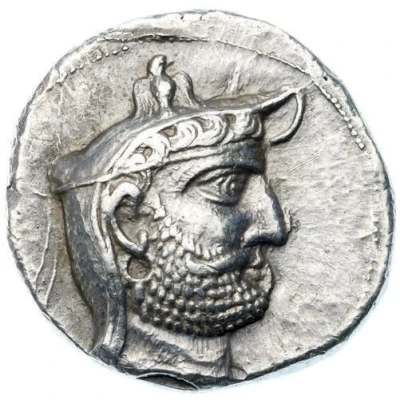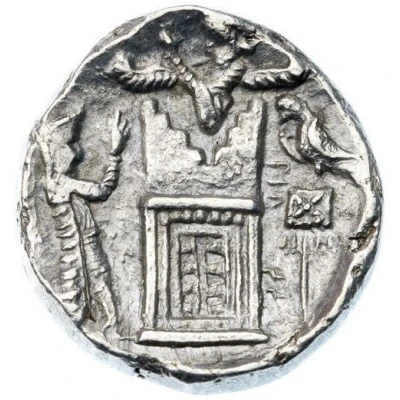


Tetradrachm - Autophradates II 138 BC - 110 BC
| Silver | 16.73 g | 25 mm |
| Issuer | Kingdom of Persis (Persian Empires) |
|---|---|
| Dynast | Wadfradad II (Autophradates II) (Late 2nd-century BC) |
| Type | Standard circulation coin |
| Years | 138 BC - 110 BC |
| Value | Tetradrachm (4) |
| Composition | Silver |
| Weight | 16.73 g |
| Diameter | 25 mm |
| Shape | Round (irregular) |
| Technique | Hammered |
| Demonetized | Yes |
| Updated | 2024-10-10 |
| Numista | N#410135 |
|---|---|
| Rarity index | 100% |
Reverse
Fire temple of Ahura-Mazda; above, half-figure of Ahura-Mazda; to left, king standing right; to right, eagle standing left on standard.
Edge
Plain
Comment
Persepolis mint.
The reign of Autophradates II is known only from his coins, which are especially notable for showing the breakdown of Seleukid authority in the eastern satrapies. After the death of Alexander the Great, his generals divided his empire amongst themselves, subsequently warring with one another for control of the various provinces and satrapies. Seleukos I came to control of the entire eastern portion of the realm, but his successors based their power in the west, in Syria and Mesopotamia, leaving the eastern regions under only nominal control.*By the later third century the local governors of Persis had begun issuing their own coins, but were mindful to pay nominal respect to their Seleukid overlords by incorporating the title frataraka, i.e., local ruler-priests, in the design. Sometime during the first half of the third century however - perhaps after the Roman defeat of Antiochos III at Magnesia in 190 BC, or around the the time of Antiochos IV's failed anabasis to recoup the Iranian plateau 164 BC - Autophradates II dropped the pretense of subservience and began issuing coins which either wholly lacked the title of ruler-priest or employed the title of king. This drew no consequence from the Seleukids who were powerless to reassert their authority in the east, and continued throughout the duration that the rulers of Persis struck coinage.
Interesting fact
One interesting fact about this coin is that it features a unique blend of Persian and Greek influences in its design. The obverse side of the coin depicts a portrait of Autophradates II wearing a traditional Persian crown, while the reverse side features a Greek-style image of the goddess Athena. This fusion of cultural styles reflects the complex history of the Kingdom of Persis, which was a vassal state of the Seleucid Empire and later became an independent kingdom, and its rulers' attempts to blend Persian and Greek traditions.